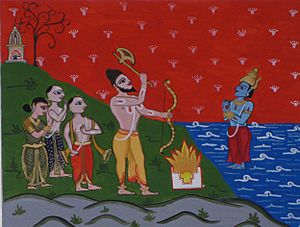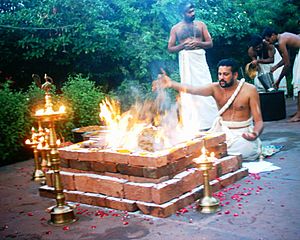Nambudiri facts for kids
The Nambudiri people, also known as Namboodiri or Namboothiri, are a group of Malayali Brahmins. They originally come from Kerala, a state in India.
For a long time, the Nambudiris were very powerful landowners in the Malabar region. They owned much of the land until the Kerala Land Reforms began in 1957. The Nambudiris are known for their special traditions and strong religious practices. Their influence was felt in many parts of life in Kerala, including religion, politics, society, and culture.
Contents
History of the Nambudiris
How the Nambudiris Came to Kerala
Nambudiri stories say that their ancestors came to Kerala from areas near the Narmada, Krishna, and Kaveri rivers. They link their arrival to a legend about Parashurama, who was the sixth avatar of the god Vishnu. According to this story, Parasurama created Kerala by throwing his axe into the sea.
We know that the Chera dynasty once ruled the area that is now Kerala. However, there is not much information about the early people who lived there. Some experts believe that Nambudiris are descendants of Brahmins from an older period called the Sangam period. These Brahmins might have moved to Kerala during a time called the Kalabhra dynasty rule.
Nambudiris wear their traditional hair tuft (a small bunch of hair) at the front of their head. This is different from other Brahmins in South India who wear it at the back. Historians think that Nambudiris brought an early version of the famous Indian epic, the Mahabharata, which later influenced the Malayalam language version.
Historians also note that Nambudiri Brahmins were present in Kerala before the 800s. Rulers gave them land that was free from taxes. This was often in exchange for performing special religious ceremonies. These ceremonies helped the rulers seem more legitimate and powerful. Nambudiris also gained more land and power by helping rulers during wars between the Chola dynasty and Chera dynasties. During these times, their religious schools even became military training centers.
Early Life and Influence
The Nambudiris lived in special houses called illam. Over many centuries, they gained ownership of a lot of farmland through a system called janmi. They also built temples and taught people about the rules of the caste system.
Nambudiri Brahmins are also credited with bringing Sanskrit words into Malayalam, which is mainly a Dravidian language. They did this by mixing Sanskrit with the local Tamil language.
During the Middle Ages, Kerala was largely controlled by the Nambudiris. They owned all the temples and the villages connected to them. They also had influence over the ruling families through a practice called sambandam. This was a type of relationship where younger Nambudiri men had relationships with women from the Kshatriya caste or the higher parts of the Nair caste.
The children from these relationships were not considered Nambudiris. Instead, they became part of their mother's family line. Because of these unions, many kings and rulers in Kerala had Nambudiri fathers. This helped the Nambudiris gain political power, along with their religious and cultural influence.
The Nambudiris kept their land through strict rules about inheritance. Only the eldest son inherited property, and family lines were traced through the father (called patrilineal inheritance). Even though younger Nambudiri men had relationships with Nair women, whose families traced their lines through the mother (called matrilineal), Nambudiri families generally kept to themselves.
Some historians once thought that Nambudiris forced matrilineal customs on other groups. However, other scholars believe that these matrilineal customs were already present in the area long before the Nambudiris.
Changes in Modern Times
The Nambudiris were slow to accept changes in society until the early 1900s. Some historians believe their power began to lessen between 1729 and 1748. This was when Marthanda Varma created the Kingdom of Travancore. He chose to use Brahmins from Tamil Nadu in his government instead of Nambudiris. This decision may have weakened the connection between Nambudiri Brahmins and the royal families.
Others argue that the biggest changes came with the arrival of British administrators in the early 1800s. The British Parliament passed laws in 1833 and 1853 that encouraged Christian missionaries. These missionaries helped with education. The British also introduced a new legal system. These changes greatly affected how Nambudiris and Nairs owned land, inherited property, and arranged marriages. These new ways challenged the traditional life of many groups in Kerala, including the Ezhavas and Syrian Christians.
Religious Customs
Vedic Learning
The Nambudiris were very learned in the ancient Hindu scriptures called the Vedas. They studied different parts of the Vedas, including:
- The Rigveda: They followed a specific version of the Rigveda called the Śākala recension. They also used two different sets of rules for their rituals, called Āśvalāyana and Śāṅkhāyana Śrauta Sūtras.
- The Yajurveda: They followed the Taittirīya version of the Yajurveda, with three different sets of ritual rules.
- The Samaveda: They studied the Jaiminīya version of the Samaveda, which is very rare and found mostly among Nambudiris and a few other Brahmin groups.
Agnicayana Ritual
The Agnicayana is a very old Vedic ritual that involves building a special fire altar. It lasts for 12 days. Nambudiri Brahmins continued to perform this ritual until at least 1975. Some experts say it was one of the oldest known rituals. While it might have mostly stopped in other parts of India, it is still performed regularly in Andhra Pradesh.
Traditional Attire
Traditionally, Nambudiri men wore a simple cloth called a thorthu (or thortumundu) around their waist when they were at home. When they traveled, they would wear two more pieces of cloth called a vasthram.
Nambudiris also wore their traditional hair tufts, called kuṭumi or śikhā, at the front of their heads. This style is similar to the Dikshitars of Tamil Nadu.
Marriage Customs
Nambudiri Brahmin families had very strict rules about marriage and inheritance, even stricter than other Brahmin groups in India. This was called primogeniture. Under this custom, only the eldest son was allowed to marry a Nambudiri woman. This meant only the eldest son could have children who would inherit the family property.
Younger sons were only allowed to have sambandam relationships with women who were not Brahmins. The children from these relationships were not considered Nambudiris and could not inherit property. This tradition limited marriages within their own caste. It also led to a practice called hypergamy with the Nair community. Hypergamy means marrying someone from a higher social group.
Because of the difference in social status, a Nair woman in a relationship with a Brahmin man could not live with him in his family's home. She stayed with her own family. The children from these marriages always became Nairs. Some historians believe this type of relationship led to the matrilineal and matrilocal system (where the wife stays in her own family's home) among the Nairs.
This practice was not very common outside the higher Nair groups. By the 1920s, Nambudiris had mostly stopped these types of relationships.
Koodiyattam (Art Form)
The ancient form of Sanskrit theater called Koodiyattam is native to Kerala. The Nambudiris traditionally supported and encouraged this art form.
|




